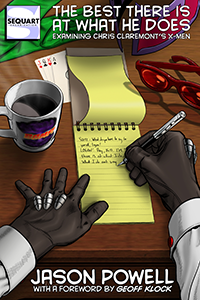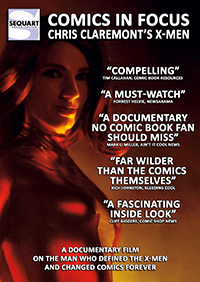Sequart has a new documentary all about Chris Claremont. We sat down with director Patrick Meaney to talk about comics, filmmaking, and working with Claremont:
SEQUART: A lot of the times documentaries get a critical pass so long as they’re about something fairly “significant.” With a documentary like this you’re aimed at a very specific niche, and lacking some of that automatic respect, how does that change your approach to the material (or does it)?
PATRICK MEANEY: I think the key with any documentary, no matter the subject, is finding a way to make people care about your subject and story. A lot of issue docs coast by preaching to the choir, so my goal with any project is to present the material and let people make their own conclusions. I think that Chris’s story is an important one, I think it’s a piece of pop culture history, and also a relevant look at the role of individuals within a corporation. That’s material anyone can relate to, and my goal with the film is to let people experience that story and come to their own conclusions about it.
SEQUART: I saw Chris Claremont speak at a con last year and noticed he had a tendency to digress and meander when he spoke, was that something you noticed filming him? How much of your interviews ended up on the cutting room floor?
PATRICK MEANEY: Chris definitely can talk in that way, moving from story to story and really expounding on points, but that’s actually great from a filmmaking point of view because it gives us a lot of material to work with. In all the other films we did (i.e. Grant Morrison, Warren Ellis, and The Image Revolution), we shot about 50 interviews and had at least 50 hours of material to cut down into an 80 minute film. With this movie, we shot probably 10-12 hours of footage for a 40 minute film, so a lot less was not used.
But, the biggest storytelling in a doc comes in the editing room, and I edited Chris’s interviews down into a clear narrative in a way that no one can do when speaking off the cuff. There’s a lot of interesting stuff that’s not in the film, but it’s available on the DVD and download packages available here on Sequart.
SEQUART: You’ve made quite a few of these documentaries at this point; do you have a certain rhythm you stick to, or is each experience fairly different?
PATRICK MEANEY: I always have the same basic principle, of letting the people who lived these events tell the story with a minimum of editorial manipulation. That worked really well for Grant, Warren, and Image, but with this film, it’s a bit more intimate and focused. Rather than doing a broad story of a whole life, or a company forming, it’s about one work and one writer, and I think, more than in the other films, I had a specific point in making this. I think Chris is a hugely underappreciated and undervalued creator, and this film is designed to show the vast impact he had on comics and media as a whole. To present the narrative in a streamlined way, we used a narrator, which was not a feature of any of the other films. So, with each movie, you’re learning the techniques and style necessary to tell a given story.
SEQUART: A topic like this is a bit of a challenge to represent, there’s nothing particularly cinematic to call on, yet the end result is visually interesting, how much of a struggle is it to maintain that quality?
PATRICK MEANEY: That’s always the challenge with an interview based documentary. A lot of people use the term “talking head” as a derogatory thing, but I think it’s fascinating to look at people and see their passion or feeling as they tell a story. But you don’t want it to just be that, and with this film, the idea was to use an analog approach to presenting the visual elements. Rather than use digital scans of the comics and manipulate them, we decided to shoot all our images from the original comics, and let people engage with the same physical object that people read. It gives a different vibe to the movie, and I’m pretty happy with how it turned out.
SEQUART: And speaking of the visual quality, there’s always the danger that, in attempting to keep something like this compelling, you could over-produce it and wind up with something cheesy; how tricky is that tightrope walk?
PATRICK MEANEY: It’s tricky for sure. In this film, we used several cosplayers to help illustrate the story, and there was a lot of debate over whether this was a good idea and how to make it workable. We wound up just using characters who translated well to the screen, and whose costumes looked good on a real person. So, Magneto was out, but Storm, Phoenix and Emma Frost all worked great. I hope they work for people. I can’t be sure, but I think they do.
SEQUART: What sort of documentaries are you drawn to? Where do you look for inspiration for these projects?
PATRICK MEANEY: I mainly look for inspiration from narrative films, and from the comics themselves. For Grant or Warren, the idea was to replicate the mental space of those authors’ works in the film. It’s a bit more experimental than most documentaries. I definitely watch some films and try to pick up what works, but people like Terrence Malick or Wong Kar-Wai are a bigger influence on my visual approach.
SEQUART: How much do you worry about appealing to non-comic fans when you make a documentary like this? Would you recommend this film to someone who’d never read a Claremont X-Men comic?
PATRICK MEANEY: I always try to make it accessible to someone who has no previous information. With this film, I’m lucky that most people are familiar with the basics of the X-Men, so a story about creating Wolverine or Storm can resonate even with a non-comics reader. I think this film is a story about the artist vs. a business, of an individual vs. a corporation, and that’s something that everyone can relate to today. I’d definitely recommend it to someone unfamiliar with Claremont, and I hope that after seeing the film, they might want to take a look at some of his books.
SEQUART: I think it’s clever you interview a lot of these people individually as well as in groups, it adds a nice dynamic to what could be a lot of talking heads. Does the spontaneity of it make it more difficult from a technical side than the one-on-one interviews?
PATRICK MEANEY: The roundtable interview with Chris, Ann and Louise was great because it brought back a lot of memories for them. With a one-on-one interview, it can sometimes feel like a lecture; with the roundtable, it has a sense of discovery because these people are reconnecting with each other and bringing something fresh and new. It’s a little trickier to shoot, and it can be awkward to integrate if you have 40 individual interviews and one roundtable, but I think the ratio here works.
SEQUART: I noticed you focused entirely on the comics. You touched on some of the post-Claremont run but stayed away from some of the massive media endeavours Claremont’s characters are currently a part of. Obviously there are the movies, but even in the comics these are still hugely successful characters. I really like how comic-centric the result is, but I was wondering what kept you away from those other topics?
PATRICK MEANEY: I wanted to make a movie that focused on the actual work that Claremont did. We didn’t have access to the creators of the films or anyone who could add real insight beyond what the average viewer would know, so I’d rather focus on the story of the run itself and let the viewers themselves bring their own knowledge of its legacy to the film. If I could have interviewed Hugh Jackman, that’d be great, but honestly, Chris made these characters and knows them better than any of the filmmakers, who are just doing cover versions of his work.
SEQUART: So many people have been so influenced by Chris Claremont’s work; what’s it like making a film about someone so adored? It’s a pretty even-handed documentary, which I wasn’t necessarily expecting. It would be too easy to turn a project like this into pure hero worship. Was that something you thought about? How emotionally connected were you to the topic?
PATRICK MEANEY: I’m a huge fan of Chris’s run, but I actually think he’s a bit underrated in comics circles right now. He’s where Hitchcock was in the late 60s, or Kirby in the 90s: still creating, but considered kind of old fashioned. I love Kirby, but there’s so much outcry over him getting credit for The Avengers, when there’s little resemblance between the film and any of his work. No one ever talks about Chris getting his due from a movie studio, even though the X-Men films are directly based on his writing. It’s a huge disconnect for me, and I think in twenty years people are going to rightly place Chris among the top creators in the medium’s history.
But I’m also aware that Chris struggled to maintain his vision in the late 80s and early 90s, in the face of crossovers and editorial interference. To me, the film is in some ways a tragedy, of someone who created so much great work and became so successful it backfired. But I’m also trying to express the enduring resonance of his work, beyond the canonical stories like “The Phoenix Saga” or “Days of Future Past”. I have no interest in hero worship, but I think it’s very cool to hear someone who never really got a chance to tell his own story do so on film, and I hope the movie makes people take a second look at his work and legacy.























































Kirby invented most of the characters Clairmont initially worked with. That’s why there was the outcry in Kirby’s favor. Mr Clairmont did make some royalites from some of the characters he created in the X-Men thought I do not know if that extended to the films. It’s still more than the Kirby family got.